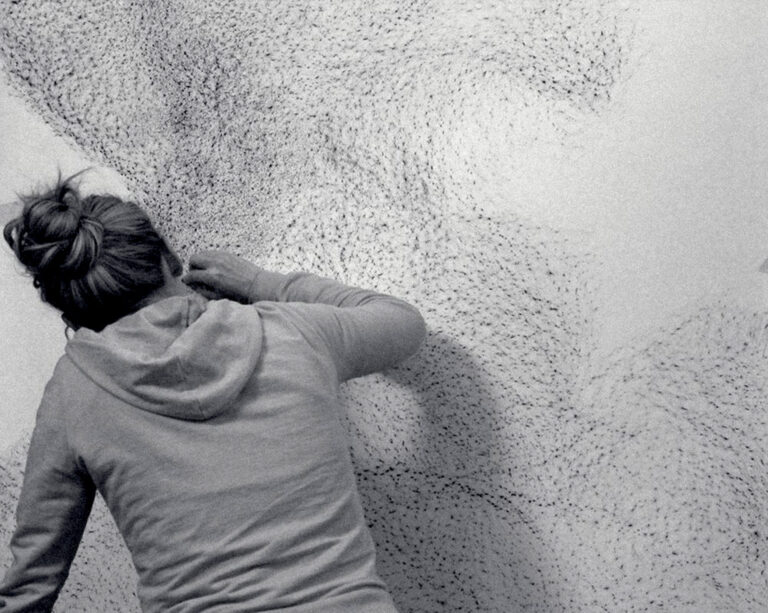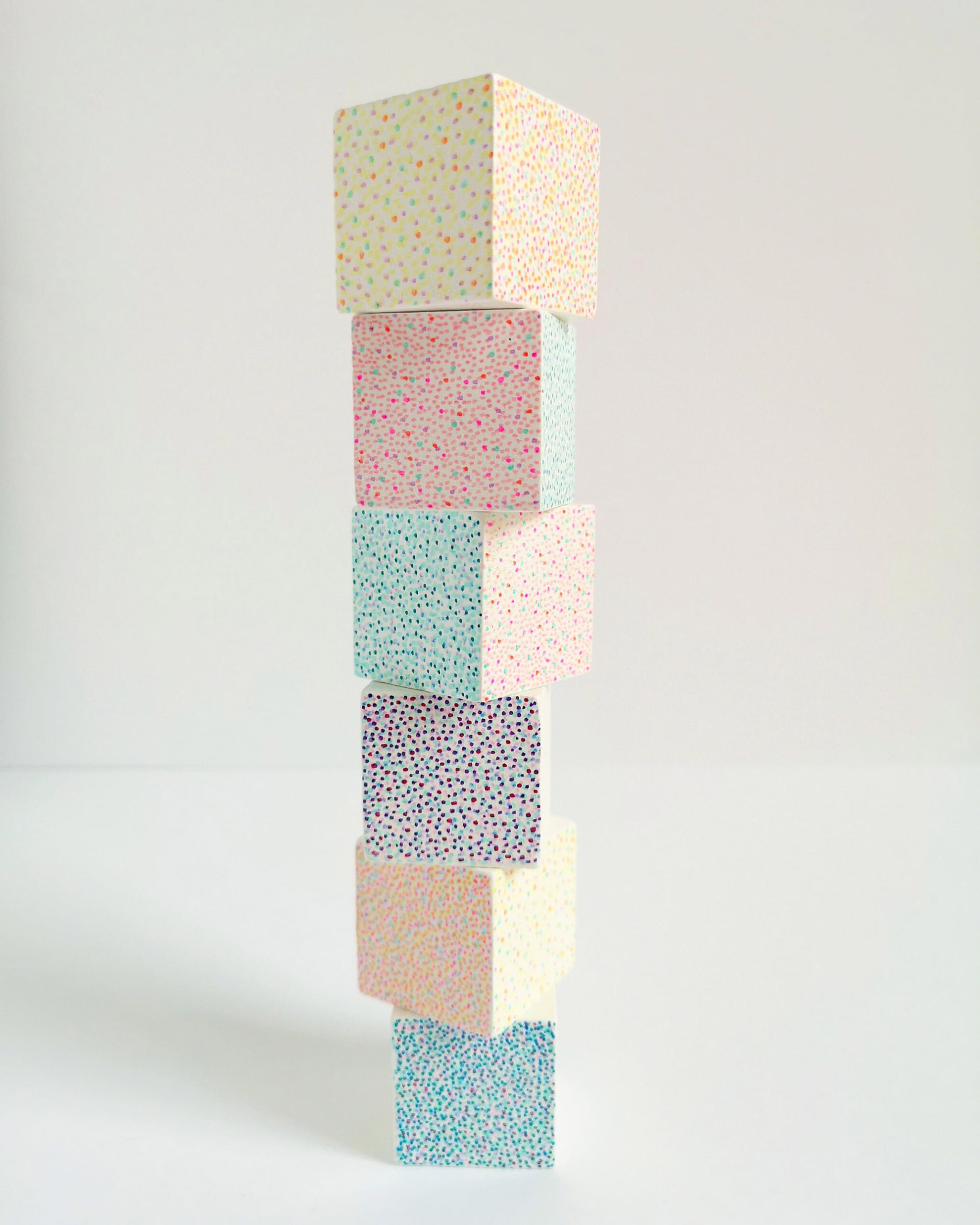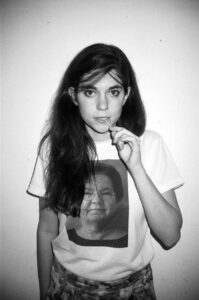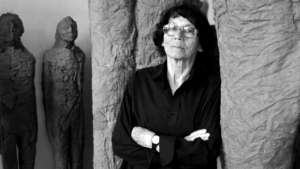Erika Fábián

– born in 1988, Budapest. She graduated from the Hungarian University of Fine Arts with a degree in Graphic Arts. For the past four years, she has been engaged with abstract projects based on optical colour mixing techniques. Her pictures build up from thousands of colour dots, which, assembling into fields, create atmospheric colour dynamics. The purpose of her works is to create an intimate, sensitive phenomenal space, where the spectators can become an active part of the colour formation process. A space where an interaction between the environment, the audience and the artwork is possible, and an artwork which is a complete entity on its own. Since 2019, Erika Fábián teaches drawing and visual studies at the Fine Arts and Media Design Departments of the University of Eger.
Living in a fast-paced world, we would think we have time for everything, when, in fact, we constantly feel we do not have time for anything and what we do have is not enough, either. One of the biggest traps of this fast pace is its ability to make us forget our thoughts, memories, leaving us no time to face our weaknesses and imperfections. We do not like to remember. Speed is our best strategy for distraction; it is something that bypasses the fundamental questions of our existence. This lifestyle, in turn, leads to burnout. I do not know why I do what I do; I do not know what the purpose of it all is. I just feel an infinite emptiness, a state without contents and purpose. Science has undoubtedly played a large role in the extent of social acceleration that we talk about today. In Darwin’s words, “A man who dares to waste one hour of time has not discovered the value of life.” Worldwide, numerous movements try to bring awareness to this problem. There are several initiatives currently in action, urging people to slow down. Although I am not a part of any of these, I share their views.
I only own a small number of artworks and for conscious reasons as well. I have intentionally slowed down the rhythm of producing my works, by choosing the tools and forms of creation needed for them. Stability and continuity are important to me. By continuity, I mean the continuity that nature and our own biological clocks offer us. My series, my picture-pairs, are not finished works in the sense that I allowed myself the opportunity to continue them any time in the future. I do not want my projects to have a clear end, for they offer me a form of natural rhythm that I can always escape to whenever societal pressure wants to take me away from them. At first glance, my pictures may seem peaceful; however, I experience them as battle fields. The process of creation is monotone and can take up years, during which neither the end date nor the finished product itself are foreseeable. It is specific to my method that I only get to see tiny details of my work in progress, and the quadrants build up slowly over time to join the finished parts. Over the long period of time that it takes to create my art, I have time to observe myself and see my imperfections, have a dialogue and even argue with myself, and grasp all the stimuli that affect me. These are not always pleasant experiences and thoughts; to the contrary, sometimes they can be maddening, hence my experiencing the process as going into battle. While naming the creation process battles, however, it should be stated that these are quiet battles whose labors are quiet pictures.
This continuous inner monologue, or inner struggle, creates a bridge inside me to my psyche’s less conscious shores. This is where the imagined and real memories reveal themselves, which are not my own only; these are the ones my family has held for generations and that shape me, too. I imagine the “place” or the state where and wherein I find this as a three-dimensional coordinate system, a matrix that builds up similarly to my pictures—to the opposite, in fact, it is my pictures that build up like this thick fabric, containing millions of tiny dots. These dots are memories, phenomena, each a trace left by a member of the countless of generations that preceded me. No matter how deep one looks, they will find more and more dots beyond the surface, just like it is the case with my works. The dots can stand for anything: memories, traumas, loves. When one is searching among them, one becomes closer to their own present-day problems. They begin to understand where their anxiety is rooted, and why they behave the way they do in certain situations. Traumas are preserved and they echo in my everyday life; my behavior and actions resonate to the horrors that others experienced in the long-gone past. The traces of current events mix into this field, and the two together create a snapshot of me, of how I am mirrored in each given situation. It is not wholly me; it merely is a projection of all that I carry within myself, inseparable from me.
I would not be able to reach this state if slowness was not my tool. Just as fastness, so does slowness have various levels. “It’s just slow and that’s it,” one would say, and nothing more is worth mentioning about it. However, like science digs deeper into the world of particles smaller than atoms and discovers something new all the time, slowness acts the same way as well. The more I reduce my pace, the larger spectrum of phenomena becomes perceivable for me. From this point of view, I find John Cage’s work entitled ASLPS, As Slow as Possible, exemplary. The musical piece began playing in 2001 in Halberstadt, Germany, in a church raided during the Napoleonic Wars and famous for its several hundred years old organ. With the help of its supporters, the concert will go on for 639 years. The piece started with a pause in 2001 that lasted seventeen months, and then in the beginning of 2003, an organist played three notes that would be “contained” inside the church’s walls until the summer of 2004 before they were followed by the next two notes. According to some visitors, the given notes can indeed be heard even after a year. They interact with the building’s walls and other parts to create a complex sound.
This project inspires me to create works that one can almost entirely see into, for they are not able to “run away” from us. Like in the case of John Cage’s project, I too can only see a tiny detail of my complete work at a time, for a very long period. The result is something that loses its purpose and dissolves in the creation process, because, as it holds true for the above-mentioned work as well, I too cannot know what resonance the given quadrant that I place onto the working surface will generate. I do not feel it my place to decide how a freshly-placed color field would impact the complete work; I merely aim to make sure that everything happens in its right place, at the right time123456789.
The final version of the statement was edited in collaboration with curator Róna Kopeczky (2020).
1Image: Erika Fábián, Untitled 04, 2015, chalk on paper, 150 x 110 cm. Courtesy of the artist.2Image: Erika Fábián, Untitled 06, 2015, chalk on paper, 150 x 110 cm. Courtesy of the artist.
3Image: Erika Fábián, Untitled 07, 2015, chalk on paper, 150 x 110 cm. Courtesy of the artist.
4Image: Erika Fábián, Pink Diptych I, 2018, acrylic on canvas, 148 x 148 cm. Courtesy of the artist.
5Image: Erika Fábián, Pink Diptych II, 2018, acrylic on canvas, 148 x 148 cm. Courtesy of the artist.
6Image: Erika Fábián, Viola, 2018-2019, acrylic on canvas, 148 x 148 cm. Courtesy of the artist.
7Image: Erika Fábián, Praise – Hommage à Agnes Martin, 2020, pencil on canvas, 30x30 cm. Courtesy of the artist.
8Image: Erika Fábián, Family Games, 2020, wooden cubes, pencil on paper. Courtesy of the artist.
9Image: Erika Fábián, Slow Game, 2020, acrylic on wooden cube. Courtesy of the artist.
– szül. 1988, Budapest, a Magyar Képzőművészeti Egyetem grafika szakán végzett. Az elmúlt négy évben optikai színkeverési technikákon alapuló absztrakt projektekkel foglalkozott. Képei színes pontok ezreiből épülnek fel, amelyek mezőkké összeállva atmoszférikus színdinamikát teremtenek. Munkáinak célja egy intim, érzékeny fenomenális tér létrehozása, ahol a nézők aktív részévé válhatnak a színképződés folyamatának. Egy olyan tér, ahol a környezet, a közönség és a műalkotás kölcsönhatása létrejöhet; egy olyan mű, amely önmagában is teljes entitás. 2019 óta Fábián Erika rajzot és vizuális stúdiumokat tanít az egri Egyetem Képzőművészeti és Média Design tanszékein.
Egy sebesség-orientált világban azt gondolnánk mindenre van időnk pedig úgy érezzük soha semmire sincs és ha van az sem elég. A gyorsaságnak az egyik legnagyobb csapdája, hogy feledteti a gondolatainkat, emlékeinket, nincs idő szembenézni gyengeségeinkkel, tökéletlenségünkkel. Szeretünk nem emlékezni. A sebesség a legjobb figyelemelterelő stratégiánk, amely megkerüli egzisztenciánk alapvető kérdésköreit. Ennek az életvitelnek az eredménye pedig a kiégés – burnout. Nem tudom, hogy miért csinálom, amit csinálok; nem tudom mi a célja annak, amit csinálok. Csak végtelen ürességet érzek, tartalom és célnélküliséget. A tudomány tagadhatatlanul nagy szerepet játszott benne, hogy ma ilyen mértékű gyorsulásról beszélhetünk. Darwin így fogalmaz: „Az az ember, aki vesztegeti az idejét, nem fogja felfedezni az élet értelmét.” Erre a problémára számos mozgalom próbálja felhívni a figyelmet világszerte. Rengeteg kezdeményezés van jelenleg, ami a lassításra a ’SLOW’-ra buzdítja az embereket. Én egy ilyen kezdeményezésnek sem vagyok a tagja, de osztom ezeket a nézeteket.
Alapvetően kevés műtárgyam van és ennek teljesen tudatos okai vannak. A képeim készítésének ritmusát szándékosan lelassítottam, a létrejöttükhöz szükséges eszközök és kivitelezési formák megválasztásával. Számomra fontos az állandóság és a folytonosság. A folytonosság alatt értem azt a magától adódó folytonosságot, amit a természet és saját biológiai óránk kínál számunkra. Sorozataim, kép-párjaim nem befejezett alkotások abban az értelemben, hogy lehetőséget adtam magamnak arra, hogy bármikor folytathassam őket. Munkáim végére nem akarok pontot tenni, ugyanis számomra a természetes ritmust kínálják, amihez bármikor vissza tudok menekülni, amikor a társadalmi nyomás ki akar szakítani belőle. Képeim első látásra békésnek tűnhetnek, de én csataterekként élem meg őket. Az alkotási folyamat monoton, és éveket ölelhet fel, nem belátható sem az elkészültének időpontja, sem pedig a kész kép. Munkamódszerem sajátossága, hogy a készülő kép apró részleteit látom csak, és a kvadránsok lassanként adódnak hozzá a már elkészült részekhez. A hosszú idő alatt amíg elkészül egy munkám, van időm megfigyelni magam és látni hiányosságaimat, időm beszélgetni vagy vitázni sajátmagammal és felfogni az engem érő ingereket. Ezek nem mindig kellemes tapasztalatok és gondolatok, sőt néha őrjítőek és ebből kifolyólag inkább élem meg csataként a munkafolyamatot. De ha már csataként aposztrofáltam a képalkotást, akkor ezek inkább csendes csaták, amikből csendes képek születnek.
Ez a folyamatos belső monológ, a belső küzdelem ver hidat bennem a psziché kevésbé tudatos partjáig. Itt sejlenek fel előttem azokat a vélt és valós emlékek, amik nem csak a sajátjaim; azok, amiket generációk óta magában hord a családom és amik rám is hatással vannak. A ’helyet’, vagy az állapotot, ahol-amiben mindezt megtalálom, úgy tudom elképzelni, mint egy háromdimenziós koordináta rendszert, mint egy mátrixot, ami hasonlóan épül fel, mint a képeim – valójában fordítva, a képeim épülnek fel úgy, mint ez a sűrű szövet, benne a milliónyi apró ponttal. A pontok mind emlékek, fenomének, egy nyom, amit a számtalan generáció valamelyik tagja hagyott, és akármilyen mélyre néz is le az ember, a pontokon túl újabb pontokat talál, akárcsak a képeim esetében. A pontok lehetnek bármik: emlékek, traumák, szerelmek. Amikor az ember közöttük kutakodik, közelebb kerül saját jelene problémáihoz. Kezdi megérteni, honnan származik a szorongása, miért viselkedik úgy ahogy viselkedik egyes élethelyzetekben. A traumák megőrződnek és az én hétköznapjaimban visszhangoznak, a viselkedésem és cselekedeteim rezonálnak a sok-sok éve, mások által átélt szörnyűségekre; és ebben a mezőben keverednek össze a jelenben zajló események nyomai is, a kettő együtt hozva létre azt a pillanatképet magamról, ahogyan az egyes élethelyzetek tükrében látszom. Nem teljesen én vagyok, csupán egy vetülete annak, amit magamban hordok, de elválaszthatatlan tőlem.
Nem lennék képes eljutni idáig, ha nem a lassúság lenne az eszközöm. Mint, ahogy a gyorsaságnak, úgy a lassúságnak is vannak fokozatai. ’Egyszerűen lassú és kész’ – mondhatnánk, a többi pedig már nem is érdekes. De hasonlóképpen, ahogyan az atomoknál kisebb részecskék világába ás a tudomány és mindig felfedez valami újat, úgy ez igaz a lassúságra is. Minél inkább csökkentem a tempót, a fenomének annál nagyobb spektruma válik érzékelhetővé. Ebből a szempontból irányadónak tekintem John Cage – ASLPS, vagyis ’Olyan lassú, amennyire csak lehet’ című művét. A darabot 2001-ben kezdték játszani Németországban, Halberstadt-ban egy a Napóleoni háborúkban kifosztott templomban, mely híres többszáz éves orgonájáról, és a támogatók jóvoltából 639 évig fog tartani a koncert. A darab 2001-ben egy szünettel kezdődött, mely tizenhét hónapig tartott, majd 2003 elején egy orgonista leütött három hangot, ami egészen 2004 nyaráig ’maradhatott’ a falak között, mielőtt követte a soron következő két hangjegy. A hangjegyek egyes látogatók elmondása alapján valóban hallhatóak akár egy év elteltével is. Kapcsolatba lépnek az épület falaival és más részeivel és összetett hangzást hoznak létre.
Ez a projekt is inspirál arra, hogy olyan munkákat készítsek, amelyekbe szinte teljesen belelátni, mert nem képesek ’elfutni előlünk’. John Cage projektjéhez hasonlóan én is a teljes mű csak egy apró részét látom nagyon hosszú időn keresztül. A végeredmény pedig olyasvalami, ami elveszíti az értelmét és feloldódik az alkotás folyamatában, mert a már említett munkához hasonlóan, nem tudom milyen rezonanciákat kelt az adott kvadráns, amit felhelyeztem a hordozó felületre. Nem is érzem feladatomnak eldönteni, hogy a frissen felkerült színmező miként befolyásolja az összképet; én csak igyekszem gondoskodni arról, hogy minden a maga helyén és idejében történjen123456789.
A statement végleges verziója Fábián Erika és Kopeczky Róna kurátor együttműködésében jött létre (2020).
1Kép: Fábián Erika, Untitled 04, 2015, kréta, papír, 150 x 110 cm. A művész jóvoltából.2Kép: Fábián Erika, Untitled 06, 2015, kréta, papír, 150 x 110 cm. A művész jóvoltából.
3Kép: Fábián Erika, Untitled 07, 2015, kréta, papír, 150 x 110 cm. A művész jóvoltából.
4Kép: Fábián Erika, Pink Diptych I, 2018, akril, vászon, 148 x 148 cm. A művész jóvoltából.
5Kép: Fábián Erika, Pink Diptych II, 2018, akril, vászon, 148 x 148 cm. A művész jóvoltából.
6Kép: Fábián Erika, Viola, 2018-2019, akril, vászon, 148 x 148 cm. A művész jóvoltából.
7Kép: Fábián Erika, Praise – Hommage à Agnes Martin, 2020, ceruza, vászon, 30 x 30 cm. A művész jóvoltából.
8Kép: Fábián Erika, Family Games, 2020, fakocka, ceruza, papír. A művész jóvoltából.
9Kép: Fábián Erika, Slow Game, 2020, akril, fakocka. A művész jóvoltából.



